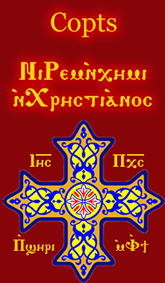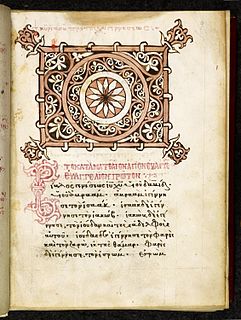Related Research Articles

There have been many Coptic versions of the Bible, including some of the earliest translations into any language. Several different versions were made in the ancient world, with different editions of the Old and New Testament in five of the dialects of Coptic: Bohairic (northern), Fayyumic, Sahidic (southern), Akhmimic and Mesokemic (middle). Biblical books were translated from the Alexandrian Greek version.
Minuscule 198, ε 311 (Soden), is a Greek minuscule manuscript of the New Testament, on cotton paper. Palaeographically it has been assigned to the 13th century. It has full marginalia.
Minuscule 272, ε 1182 (Soden), is a Greek minuscule manuscript of the New Testament, on parchment. Palaeographically it has been assigned to the 11th century. It has marginalia.

Minuscule 447, ε 507, is a Greek minuscule manuscript of the New Testament, on parchment. Palaeographically it has been assigned to the 15th century.
Huntington 17, bilingual Bohairic-Arabic, uncial manuscript of the New Testament, on a paper. It is dated by a colophon to the year 1174. It is the oldest manuscript with complete text of the four Gospels in Bohairic.
Huntington 20, is a Bohairic-Greek, uncial manuscript of the New Testament, on paper. Palaeographically it has been assigned to the 13th century.
Codex Marshall Or. 5, is a Bohairic-Greek, uncial manuscript of the New Testament, on a paper. Palaeographically it has been assigned to the 14th century.
Codex Marshall Or. 6, is a Bohairic-Greek, uncial manuscript of the New Testament, on a paper. It is dated by the Colophon to the year 1320.
Minuscule 583, ε 124, is a Greek minuscule manuscript of the New Testament, on parchment. Palaeographically it has been assigned to the 11th century. The manuscript has complex contents. It was labeled by Scrivener as 452.
Minuscule 662, ε 298, is a Greek minuscule manuscript of the New Testament, on parchment. Palaeographically it has been assigned to the 12th century. The manuscript is lacunose. Scrivener labelled it by 632e.
Codex Marshall Or. 6, is a Bohairic, uncial manuscript of the New Testament, on a paper. Palaeographically it has been assigned to the 16th century.
George William Horner (1849–1930) was a British biblical scholar, an editor of the text of the New Testament in the dialects of the Coptic language.

Codex Oriental Ms. 424, designated by siglum A1 (Horner), t (de Lagarde [= Boetticher]), is written in two languages Bohairic-Arabic, uncial manuscript of the New Testament, on paper. It is dated by a colophon to the year 1308. Many leaves of the codex were lost.
Oriental MS 426, bilinguical Bohairic-Arabic, uncial manuscript of the New Testament, on paper, now in the British Library in London. It is dated to the 13th century. The manuscript is lacunose.
Minuscule 695, ε327, is a Greek minuscule manuscript of the New Testament, on parchment. Palaeographically it has been assigned to the 13th century. The manuscript is lacunose. Scrivener labelled it by 599e.
Oriental MS 1001, Bohairic, uncial manuscript of the New Testament, on paper. Palaeographically it has been assigned to the 12th century. Several leaves of the codex were lost. Horner designated the manuscript by siglum E2.
Add MS 5995, bilingual Bohairic-Arabic, uncial manuscript of the New Testament, on paper. It is dated to the fourteenth century. The manuscript has complex contents.
Add MS 14470, Bohairic, uncial manuscript of the New Testament, with a few Armenian fragments. The manuscript is written on vellum and paper. Palaeographically it has been assigned to the 5th or 6th century. The manuscript has survived in a fragmentary condition. It is now in the British Library as Add MS 14470, under the title "PART Of the Gospel of St. John, the Epistles of St. Paul, and the Acts of the Apostles, Peshito version; imperfect". It forms part of the series Add MS 14425-14741, described in the British Library catalogue as "Manuscripts obtained from the Syrian Monastery of St. Mary Deipara, in the Desert of Nitria, or Scete".
Oriental MS 1001, Bohairic-Arabic, uncial manuscript of the New Testament, on paper. It is dated to the year 1663. Horner designated the manuscript by siglum H3.
References
- 1 2 Gregory, Caspar René (1902). Textkritik des Neuen Testaments. 2. Leipzig. p. 538.
- 1 2 3 Scrivener, Frederick Henry Ambrose; Edward Miller (1894). A Plain Introduction to the Criticism of the New Testament, Vol. 2. London: George Bell & Sons. p. 112.
- ↑ Constantin von Tischendorf, Editio Octava maiora, vol. III, p. 870.
- ↑ George Horner, The Coptic Version of the New Testament in the Northern Dialect, otherwise called Memphitic and Bohairic, 4 vols. (1898-1905; repr. Osnabrück: 1969).